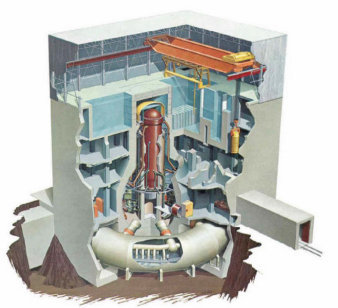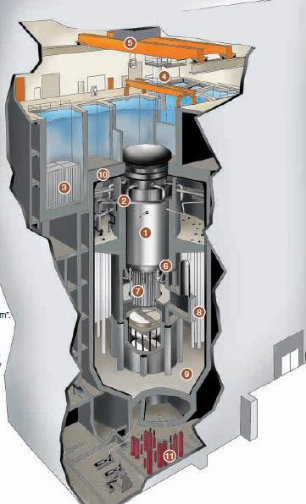Background
As a full-service provider for boiling water reactor (BWR) nuclear power plants, Westinghouse can offer engineering services for BWR safety analysis, including containment analysis. The Westinghouse BWR containment analysis methodology uses several computer codes, including GOBLIN, BISON, and GOTHIC or COPTA in performing various calculations related to containment analysis.
Description

Example of MARK I-type BWR containment

Example of MARK II-type BWR containment
The GOBLIN code is used to calculate the mass and energy (M&E) release input for loss-of-coolant accident (LOCA) events, and is based on the approved Westinghouse BWR emergency core cooling system (ECCS) evaluation model.
The BISON code is used to calculate M&E release input for anticipated transient without scram (ATWS) and other transient events, and is based on the approved Westinghouse BWR fast transient evaluation model.
The GOTHIC code, a state-of-the-art program for modeling multiphase flow, calculates the containment response. This code is rapidly becoming the industry standard for performing both inside- and outside- containment pressure and temperature design basis analyses. The code is being maintained and developed by Numerical Applications Incorporated (NAI), with funding by the Electric Power Research Institute (EPRI). The GOTHIC code has undergone extensive review and validation in an impressive array of tests. The Westinghouse generic GOTHIC BWR containment models were qualified using benchmark comparisons with transient results from the CONTEMPT, CONSBA, LOCTVS, SHEX and M3CPT codes.
The Westinghouse generic BWR Mark I containment analysis methodology has been approved by the U.S. Nuclear Regulatory Commission (NRC) for the following plant-specific analysis applications:
- Calculation of the containment peak pressure, and temperature and liner temperature for various LOCA and steam line breaks
- Calculation of the minimum containment backpressure for the ECCS analysis
- Calculation of the peak suppression pool temperature for ATWS and other events
- Generation of the thermal-hydraulic input for the ECCS pump net positive suction head available (NPSHa) calculation
- Generation of the thermal-hydraulic input for the hydro-dynamic load analysis
- Generation of the thermal-hydraulic input for equipment qualification
The Westinghouse COPTA code is a well-established program for containment analyses. COPTA is equipped with specific models for pressure vessel blowdown and break flows, as well as models for spray cooling and hydrodynamic loads. COPTA has undergone extensive validation and has for long been the chosen tool for calculation of the response of BWR containments for safety analysis in the Nordic countries.
COPTA is used in the Nordic countries for:
- Containment peak pressure and temperature for various LOCA and steam line breaks
- Calculation of the peak suppression pool temperature for ATWS and other events
- Generation of the thermal-hydraulic input for the ECCS pump NPSHa calculation
- Generation of the thermal-hydraulic input for the hydro-dynamic load analysis
- Generation of the thermal-hydraulic input for equipment qualification
Benefits
To provide the necessary containment support for safety analyses, Westinghouse uses state-of-the-art capabilities. This methodology is capable of replacing vendor analyses for BWR containment design basis events.
Experience
The Westinghouse GOTHIC BWR containment model was employed for the Quad Cities and Dresden ATWS analyses for peak suppression pool temperature.
COPTA has recently been used for the Periodic Safety Analysis Review of the Olkiluoto Units 1 and 2, as well as for extended power uprate (EPU) studies for Oskarshamn Units 2 and 3 and Forsmark Unit 3.



